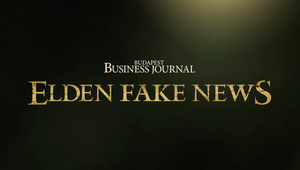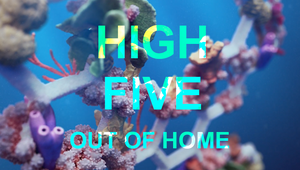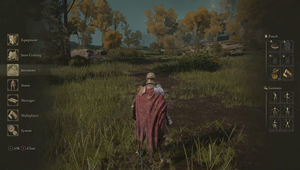
5 Minutes with… Istvan Bracsok

Istvan Bracsok, chief creative officer and founder of White Rabbit Budapest, set up the independent ad agency with his partners who, at the time, he worked with at JWT Then, Heineken put their trust in them and allowed them to take their independent path. He has been at White Rabbit ever since.
With work spanning numerous disciplines, and a background at Saatchi & Saatchi, DDB and JWT, Istvan knows the Hungarian market inside out, with all of its ups and downs. He started off as a self-proclaimed punk rocker with an aversion to office jobs, and put his foot through the ad industry’s door at a time when Hungary was still struggling to tear itself away from the former Soviet Union’s regime.
But, with an unconditional love for ideas and the core understanding that relationships are what communications are built on, Istvan became one of the legends of the Eastern European ad world. He began his career knowing he had to at some point win a D&AD pencil - and eventually he did, along with pretty much any award you can think of.
Istvan sat down with LBB’s Zoe Antonov to tell her about winning and losing Heineken, what Hungary has that other places don’t, and his career-defining project involving a lot of mud and a lot of wine.
LBB> Tell me about the start of your career and how you got your foot in the door. What are some lessons from those years you still carry with you?
Istvan> Haha! This is not an ordinary career story. Because of two reasons. The first is that I never really thought when I was a teenager that I would ever work.
Look, I was a punk rocker, and there was one thing I definitely didn't want: a regular office job. The second is that at that time (1995) in Hungary, it was not terribly difficult to get into the industry. Let's not forget that back then, it was only five years after the fall of the communist regime - everything related to the market economy was new to us. We had just started learning it. So we didn't really have real advertising professionals, just like we didn't have any specialised school or training to learn advertising at. If you had some kind of artistic flair, you were welcome as an art director, and if you had a literary degree, you had a chance to become a copywriter. In my case, what happened was that a childhood friend of mine worked at Lintas, and he said, 'Listen, this is such a cool place, it doesn't look like a workplace at all, and now we're looking for people. Interested?’ I was interested. And I was already working there five days later.
And what did I learn in the very first period of my career? The unconditional love for ideas. Plus I knew I’d have to win a D&AD pencil at some point. At that time, I didn't know when, but above all, I didn't know how.
LBB> After working at Saatchi & Saatchi, DDB and JWT, you set up White Rabbit in Budapest. What was that transition like and why did you decide it was time to go on your own, independent path?
Istvan> Founding White Rabbit was not entirely our own decision. At JWT, we had just won Heineken's largest local brand, but despite this, the agency's management decided that they no longer wanted to work with us. We had to go. Fortunately, the client who we just won thought that they wanted to continue working with the winning team and did not insist on the network agency. This was an indescribably good feeling for us. And it also showed that, ultimately, our profession is deeply rooted in human relationships.
LBB> Who did you start White Rabbit with and why were they the best partners for the endeavour?
Istvan> The founders were two creative leaders, a client service director, an account director and a senior copywriter. Two of them are no longer part of the company, but it was a perfect team for the founding and getting through the first messy period.
LBB> Tell me about the creative scene of Budapest and why it was the perfect place to set up your own company. What has changed in the creative world in Hungary since then?
Istvan> There are a few things that are absolutely worth knowing about Hungary in order to understand the local ad industry. It is a small country and it’s economically insignificant. Approximately nine million people with relatively low purchasing power. Knowing this, it is perhaps not surprising that the advertising industry also struggles with strong limitations - small budgets, only a few locally developed campaigns and not particularly brave clients. Among other things, it follows from this that the local creative culture is not optimal either.
There are some agencies, some people who want to break out of this, and there are small results from time to time. But it is not easy to break down these walls. Regardless, we are always ready to fight the good fight. But there is still a lot to do.
It follows from all of this that it is a bit of an exaggeration to say that Budapest was the perfect place to found White Rabbit. Surely there would have been a more ideal place in the world for this, but for us the location was a given.
LBB> And how has White Rabbit itself evolved? What are some pillars that remain from its beginnings?
Istvan> We spent the first year with Soproni (Heineken’s local brand), then a pharmaceutical pitch was won, and we made good progress.
The two biggest turning points were winning and losing Soproni. The latter divides the last 17 years almost exactly into two parts. We were able to start out on our own because of Soproni, this client gave us great visibility, and then when we lost it, we had to rethink everything.
LBB> A project I wanted to take a look at is ‘RODODENDRON’, tell me about its conception and the idea behind it! Why was it an important one for White Rabbit to pick up and what were the lessons learned?
 Istvan> Probably, most of you know that the ‘Iron Curtain’ was the name of the metaphoric barrier separating communist Eastern Europe from the West during the Cold War. In 1989, the symbolic fence-cutting at the Austro-Hungarian border led to the fall of the Berlin Wall, and the collapse of communist regimes in Europe. However, in Hungary, the road to democracy was a long and rough one, paved with emotional turmoils and individual tragedies.
Istvan> Probably, most of you know that the ‘Iron Curtain’ was the name of the metaphoric barrier separating communist Eastern Europe from the West during the Cold War. In 1989, the symbolic fence-cutting at the Austro-Hungarian border led to the fall of the Berlin Wall, and the collapse of communist regimes in Europe. However, in Hungary, the road to democracy was a long and rough one, paved with emotional turmoils and individual tragedies.The short film ‘RODODENDRON’ – which was actually written and directed by Levente Kovacs, my co-founder and creative partner at White Rabbit – focuses on ‘the last spark’ of communist regime before it burns away once and for all. It shows the absurdity of authoritarian systems through the story of two domestic secret agents who worked for the Hungarian Intelligence Service in the communist era.
White Rabbit not only created the production design of the film, but its communication campaign as well. We thought it to be important to raise awareness for this short, and make the Hungarian audience revisit this important period in the history of Hungary – and see those events from a different, unseen perspective. As for the visual idea of the poster, it expresses that unusual perspective - we see a badge of the communist red star, revealing that a single matchstick is holding it, symbolising the very last days of the communist regime, which is about to burn away. The illustration was created by Istvan Orosz, who is a prominent graphic designer of the Hungarian art scene, and also had experienced the communist era as well as the regime change in Hungary.
LBB> In your view, what is your most career-defining project and why?
Istvan> This one is easy to answer. The ‘Flutwein’ campaign, which we did together with the German Seven.One AdFactory/Creative House. We would also like to thank Daniel Koller for the opportunity. And a big shout out to Tom Schwarz and Friedrich-Paul Spielhagen.
The idea of the campaign was stupid simple - there was a catastrophic flood in the Air Valley. This region experienced a ‘living hell’ in the summer of 2021. More than a month's rainfall within 24 hours devastated much of western Germany, and the Ahr Valley was the hardest hit - homes, businesses, bridges, roads, entire communities were swept away. More than 46 wineries in the region lost their facilities, cellars, wine barrels, machinery and hectares of vineyards.
Our aim was to raise awareness of the economic devastation of the region, and draw attention to the financial disaster that the wine-makers of the Ahr Valley were facing. Despite the loss of the wine-makers, some 200,000 bottles of wine – soiled with mud and dirt – survived the disaster. The bottles looked impossible to sell. We created a special collection of wines from scratch, branded them as ‘Flood Wines’. Since they were coated in the original mud, we labelled them ‘authentically muddied’, and started selling them on a crowd-funding platform, dedicated to the rebuilding of the wine region.
The campaign is a massive proof that creativity can and must be effective and efficient.
LBB> What are some technological advancements that are exciting you recently? Are you excited to get stuck in, or are you more sceptical?
Istvan> Of course, AI. I wouldn't say I was neck deep in it - I'd rather just watch how it develops. It is still so fresh that it changes and expands almost every day. But I am sure of one thing - it will make a huge difference in the ad industry and in our daily lives as well. If we use it in the right way - only as a tool - it can help us. If we want to see it do more than that, well, we'll soon be in big trouble.
LBB> You're not a stranger to awards and you've won numerous throughout your career. But what do awards really mean and what is their weight within the industry?
Istvan> I think festivals are a great opportunity to take time and measure the pulse of the industry. In every field, there’s a time for doing and a time for weighing what’s been done, this in order to reassess the next steps. As a creative, being part of a jury is a great chance to burst your own judgement bubble and see what criteria the rest of the industry uses to draw the line between excellent and not so good. For the industry in general, festivals are where we award work that should stand as an example for the year to come. It’s the moment where the industry thinks which direction to steer in order to remain relevant with the time.
LBB> What are your passions and hobbies outside of work?
Istvan> When I’m not making ads, I like to go out for a big walk with my Hokkaido Ken (yes, it is a dog breed), listen to my collection of vinyl records, take care of my exotic houseplants or count clouds. I happily open a bottle of wine to accompany any of these activities.













